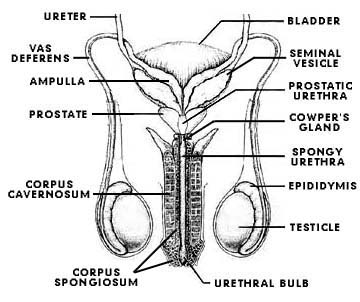A lot of people think semen is produced entirely in the testicles, is stored there, and at ejaculation, gets "pumped" from the testicles out through the penis. This view is entirely too simple – different components of semen are produced in several parts of the male reproductive system, which work together before and during ejaculation. Sperm cells, which are of course the most important component of semen reproduction-wise – are produced in the testicles (testes) in a process known as spermatogenesis. Partially mature sperm cells are constantly moving into a structure called the epididymis, which secretes a fluid that helps the sperm cells to finish maturing. Once fully mature, sperm enter the vas deferens, a tube about 18 inches long that loops over the bladder. (The vas deferens is cut and tied off in the birth-control operation called a vasectomy.) Each vas deferens ends in an expanded segment called the ampulla; this is where sperm is stored before each ejaculation.
Sperm cells, which are of course the most important component of semen reproduction-wise – are produced in the testicles (testes) in a process known as spermatogenesis. Partially mature sperm cells are constantly moving into a structure called the epididymis, which secretes a fluid that helps the sperm cells to finish maturing. Once fully mature, sperm enter the vas deferens, a tube about 18 inches long that loops over the bladder. (The vas deferens is cut and tied off in the birth-control operation called a vasectomy.) Each vas deferens ends in an expanded segment called the ampulla; this is where sperm is stored before each ejaculation.
At the base of the bladder are structures called the seminal vesicles; these join with the ampulla of the vas deferens to form the "ejaculatory duct." The seminal vesicles secrete a thick liquid rich in sugar (specifically, fructose – commonly found in fresh fruit), which is an important nutrient for the sperm cells. In fact, the seminal vesicles are where most of the non-sperm portion of semen is made.
The prostate is a donut-shaped organ under the bladder; it surrounds the prostatic urethra and secretes an alkaline (basic) fluid that accounts for up to a third of the non-sperm portion of semen.
Finally, the Cowper's glands, also known as bulbourethral glands, are small structures near the base of the penis; their function is to secrete mucus that lubricates and readies the urethra prior to ejaculation. Most guys know this secretion as "pre-cum." Some people secrete much more of it than others; in fact, many men don't even notice it at all.
During sexual stimulation, all of these organs kick into high gear to prepare for an ejaculation. The testicles get slightly larger as they become congested with blood, and the seminal vesicles, prostate, and Cowper's glands begin to secrete their respective fluids. A small amount of sperm may enter the ejaculatory duct and mix with the Cowper's secretions, which is why it is not safe during sexual intercourse to assume pre-ejaculation fluids do not contain sperm.
Ejaculation is a reflex that results from a buildup of physical and mental stimulation and encouraged by the accumulation of seminal fluids. Ejaculation itself actually consists of two phases: the emission phase and the expulsion phase. During the emission phase – commonly described as the "point of no return," when ejaculation feels imminent – smooth muscles in the various parts of your reproductive system contract, causing the seminal fluids to move into a widening of the urethra at the base of the penis. During the expulsion phase, muscles at the base of the penis strongly contract in a rhythmic, wave-like fashion, putting pressure on the corpus spongiosum – the slightly softer erectile tissue that makes up the inner portion of the penis as well as most of the glans, or head. (The harder part of the penis is the corpora cavernosa.) This causes the rapid ejection of the semen through the penis. The contractions occur about seven-tenths of a second apart and are finished in about ten seconds. After ejaculation, a small amount of semen is usually left in the urethra; this can be expelled by urinating or by gently "milking" the penis once the erection has gone down.
Do you find yourself masturbating more often during some seasons than others? Why?
Answer this question | Suggest a question
Answer this question | Suggest a question




